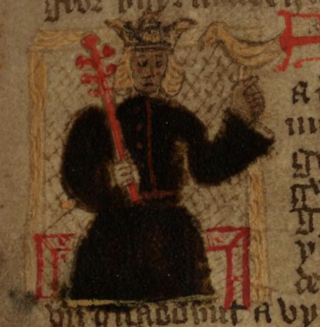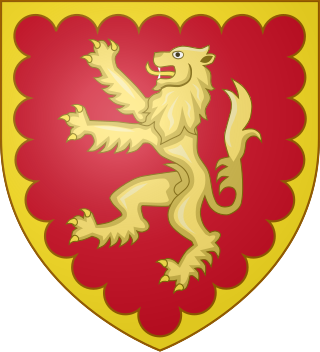
Hywel Dda, sometimes anglicised as Howel the Good, or Hywel ap Cadell, was a king of Deheubarth who eventually came to rule most of Wales. He became the sole king of Seisyllwg in 920 and shortly thereafter established Deheubarth, and proceeded to gain control over the entire country from Prestatyn to Pembroke. As a descendant of Rhodri Mawr through his father Cadell, Hywel was a member of the Dinefwr branch of the dynasty. He was recorded as King of the Britons in the Annales Cambriæ and the Annals of Ulster.

Rhodri ap Merfyn, popularly known as Rhodri the Great, succeeded his father, Merfyn Frych, as King of Gwynedd in 844. Rhodri annexed Powys c. 856 and Seisyllwg c. 871. He is called "King of the Britons" by the Annals of Ulster. In some later histories, he is referred to as "King of Wales", although the title is anachronistic and his realm did not include southern Wales.

Deheubarth was a regional name for the realms of south Wales, particularly as opposed to Gwynedd. It is now used as a shorthand for the various realms united under the House of Dinefwr, but that Deheubarth itself was not considered a proper kingdom on the model of Gwynedd, Powys, or Dyfed is shown by its rendering in Latin as dextralis pars or as Britonnes dexterales and not as a named land. In the oldest British writers, Deheubarth was used for all of modern Wales to distinguish it from Hen Ogledd, the northern lands whence Cunedda originated.

Whitland is a town and community in Carmarthenshire, Wales.

The National Library of Wales, Aberystwyth, is the national legal deposit library of Wales and is one of the Welsh Government sponsored bodies. It is the biggest library in Wales, holding over 6.5 million books and periodicals, and the largest collections of archives, portraits, maps and photographic images in Wales. The Library is also home to the national collection of Welsh manuscripts, the National Screen and Sound Archive of Wales, and the most comprehensive collection of paintings and topographical prints in Wales. As the primary research library and archive in Wales and one of the largest research libraries in the United Kingdom, the National Library is a member of Research Libraries UK (RLUK) and the Consortium of European Research Libraries (CERL).

Cyfraith Hywel, also known as Welsh law, was the system of law practised in medieval Wales before its final conquest by England. Subsequently, the Welsh law's criminal codes were superseded by the Statute of Rhuddlan in AD 1284 and its civil codes by Henry VIII's series of Laws in Wales Acts between 1535 and 1542.

Whitland Abbey was a country house and Cistercian abbey in the parish of Llangan, in what was the hundred of Narberth, Carmarthenshire, Wales. The town which grew up nearby is now named Whitland after it. It was widely known as Ty Gwyn ar Daf, meaning White House on the Taf, in reference to the country house originally built here before it became a monastic settlement which was known under that name. It is most associated with being the place where Hywel Dda drew up his laws around 940. It functioned as a Cistercian monastery between the 12th and 16th centuries.

Tŷ Hywel is a building in Cardiff, Wales, used by the Senedd. It is named after the medieval king Hywel Dda, King of Deheubarth in South West Wales. The building was previously known as Crickhowell House, after the former Secretary of State for Wales, Lord Crickhowell. It houses Members of the Senedd and their staff, as well as staff of the Senedd Commission. The Welsh Government also operates from the building and occupies one whole floor and part of another. It is leased by the Senedd under the Government of Wales Act 1998.

The Royal House of Dinefwr was a cadet branch of the Royal House of Gwynedd, founded by King Cadell ap Rhodri, son of Rhodri the Great. Their ancestor, Cunedda Wledig, born in late Roman Britain, was a Sub-Roman warlord who founded the Kingdom of Gwynedd during the 5th century, following the Anglo-Saxon settlement of Britain. As Celtic Britons, the House of Dinefwr was ruling before the Norman conquest, having to fight with their neighbors such as the Celtics, Anglo-Saxons and Vikings, before struggling with the Normans afterwards. Many members of this family were influential in Welsh history, such a Hywel Dda, who codified Welsh law under his rule, and achieved the important title of King of the Britons, or Lord Rhys, Prince of Wales, who rebelled against Richard the Lionheart, and became one of the most powerful Welsh leaders of the Middle ages.

Llaneilian is a village and community in Anglesey, Wales. It is located in the north east of the island, 2.2 miles (3.5 km) east of Amlwch, 16.5 miles (26.6 km) north west of Menai Bridge and 12.5 miles (20.1 km) north of Llangefni. The community includes the villages and hamlets of Dulas, Llaneilian, Pengorffwysfa, Cerrig Man and Penysarn, Gadfa and Nebo, and at the 2001 census had a population of 1,192, decreasing slightly to 1,186 at the 2011 Census. The parish is crowned by its hill, Mynydd Eilian, a HuMP, popular with walkers and ramblers, and its beach, Traeth Eilian, which is popular with holidaymakers and for watersport activities. At the north easternmost point is Point Lynas,, while Ynys Dulas lies off the North East coast of the island, east of Dulas Bay.
This article is about the particular significance of the year 1730 to Wales and its people.

Unionism in Wales is the political view that supports a political union between Wales and the other countries of the United Kingdom. As well as the current state of the UK, unionism may also include support for Federalism in the United Kingdom and a United Kingdom Confederation.

NLW MS 20143A is a Welsh-language manuscript of the laws of Hywel Dda dating from the middle of the 14th century. It is one of the few surviving Welsh manuscripts of the period to have a medieval binding, and has been digitised by the National Library of Wales, which acquired the manuscript in 1969.
Peniarth Manuscript 32 is a fifteenth-century volume of the laws of Hywel Dda that contains a brief chronicle from Gwrtheyrn Gwrtheneu to King John, Paul's Vision, the Tree of the Cross, Brutus Saxonum, and various englynion. It is beautifully written on vellum in the hand of the scribe responsible for the Mabinogion in the Red Book of Hergest, and is bound in white vellum.
The Boston Manuscript of the Laws of Hywel Dda is a Welsh manuscript created in south-west Wales c.1350-1400 and added to by other scribes in the later Middle Ages. The complex composition of the manuscript has been mapped by archivists at the National library Wales. It is 99 vellum leaves and 98mm by 50mm and is not illuminated, although it does use some coloured inks. It was acquired at auction at Sotherby's by the National Library of Wales in 2012 for £541,250 and is now part of the General Manuscript Collection.

Peter Lord is an English sculptor and art historian based in Wales. He is best known for his books and television programmes about the history of Welsh art, and is regarded as a leading authority on the subject. Critic Andrew Green has said that The Visual Culture of Wales, Lord's three-volume series published by University of Wales Press, "restored to Wales a narrative of visual art that had been lost or denied for decades".
Grafton Melville Richards (1910-1973) was a Welsh scholar in the field of Welsh language and literature and Celtic studies.

Welsh national identity is a term referring to the sense of national identity, as embodied in the shared and characteristic culture, languages and traditions, of the Welsh people.

The justice system in Wales is currently part of the England and Wales justice system. There have been many proposals for a Wales-only justice system under the control of the Senedd, which would be better equipped to deal with Welsh issues.















